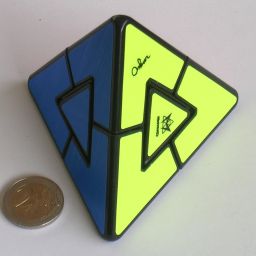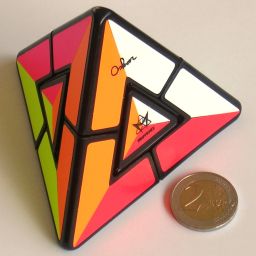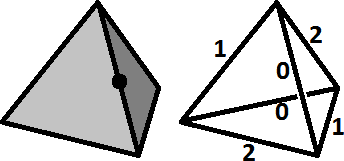



Pyraminx Duo is a puzzle in the shape of a tetrahedron, consisting of four corner pieces and four triangular face centre pieces. Each corners can be rotated, and when doing so the adjacent face centre move along with it. At the start, each face has a single colour and the aim is of course to restore this state after it has been mixed.
The puzzle was invented by Oskar van Deventer. He wanted to make the simplest possible non-trivial twisty puzzle, where a puzzle such as the Morph is considered trivial because after the first move there is no choice in subsequent ones.
The second picture above shows a version with custom stickers that make the orientations of the face centres visible. This makes it a bit more difficult.
There are 4 face centres which can be permuted in at most 4! ways. The corners can twist
independently of each other, and each has 3 possible orientations giving them 34
possible states. This gives a total of at most 4!·34 = 1,944 positions.
This limit is not reached however because of some constraints. You can consider the face
centres to be the faces of a smaller tetrahedron. Every move merely rotates this tetrahedron.
This already shows that it is impossible to swap two centres as that would not result in the
mirror image colouring of the tetrahedron rather than a rotated one. We can also define the
twist number for any orientation of a tetrahedron as shown in the following diagram.

One of the edges of the tetrahedron shown on the left is marked. Whichever orientation this
tetrahedron is given, the associated twist number can be determined by finding where its mark is,
and looking at what number this edge is given in the wire diagram on the right. You can easily
check that any clockwise rotation abouy a corner of the tetrahedron will cause the twist number
to increase (modulo 3) and that an anti-clockwise rotation causes a decrease (mod 3).
Every clockwise move on the Pyraminx Duo increases the twist number of the tetrahedron formed
by the face centres, and also increases the twist of one of the corner pieces. Therefore the total
twist of the corner pieces must be equal to the twist of the centre tetrahedron.
The total number of positions of the Pyraminx Duo is therefore 4!·34 / (2·3) = 324.
Suppose the orientation of the face centres is made visible. Each face centre has 3 orientations, potentially multiplying the number of positions by a factor of 34. However, each clockwise move twists one corner but also twists one face centre relative to the inner tetrahedron. Therefore the total corner twist must be equal to the total twist of the face centres relative to their tetrahedron. This means the orientation of one face centre is determined by the rest of the puzzle and there are only a factor 34/3 times as many positions. There are therefore 4!·38 / (2·32) = 8,748 positions when centre orientation is visible.
| No Centre Orientations | With Centre Orientations | ||||||||||||||||||||||||||||||||||||||
|---|---|---|---|---|---|---|---|---|---|---|---|---|---|---|---|---|---|---|---|---|---|---|---|---|---|---|---|---|---|---|---|---|---|---|---|---|---|---|---|
|
|
If you have visible face centres, also do the following steps.